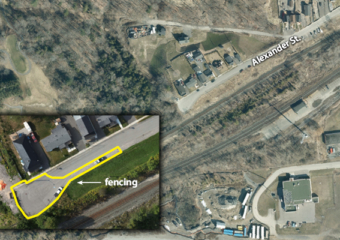Port Hope Area Initiative (PHAI) work at the Waterworks West site near the West Beach is nearing completion. Over 23,000 cubic metres of contaminated material was removed from the area, representing three times the original estimate. The cleanup of the site began with contractor mobilization in late 2022 and proved to be challenging because of the proximity to Lake Ontario.
“Groundwater management was a feature of the work at this site, as it rose into the bottom of nearly all our excavation areas. We had to truck this water to the CNL Port Hope Waste Water Treatment Plant for processing before it could be released” shared Mark Gardiner, Project Manager.
It was the volume of water coupled with the depth of contamination that led to the special circumstances application being approved by the Municipality of Port Hope (MPH) for the eastern section of the site near the West Beach area. This means historic low-level radioactive waste (LLRW) will be left in in an isolated area approximately 2 to 4 metres below the ground surface. This application followed the established protocol for special circumstances made by a qualified person, which ensures that when any material is left in place, it is in a manner that protects human health and the environment.
The plans for restoration in this area, like all PHAI projects, are based on direction from property owners, in this case, the Municipality of Port Hope. Restoration of the eastern section of the site has already been completed with final touches planned for this spring, including the replacement of the current border stones in the parking lot area. These will be replaced with a more naturalized version and the current stones used at another PHAI project site. This section of the site is expected to be used recreationally.
The western section of the site is expected to be restored in a more naturalized state starting this spring. Feedback from Indigenous communities, regulators including the Department of Fisheries and Oceans Canada (DFO), Ontario Ministry of Natural Resources (MNR), the Ganaraska Region Conservation Authority (GRCA) and MPH are all incorporated in this restoration planning.
Central to these plans is the restoration of the Alexander Creek and the wetland area with deeper pools to encourage restoration of the fisheries habitat. The newly restored wetland area and the already established Alexander Creek will not be in contact with contaminated soil that will remain at depth within the eastern portion of the site.
As part of CNL’s relationship with Indigenous communities, as well as federal requirements under the Canadian Constitution Act, 1982, the Crown’s Duty to Consult and the UNDRIP Act, CNL engaged with the Williams Treaties First Nations as the Treaty Rights holders with interests in the Alexander Creek ecosystem and fishery. Those Treaty Rights were re-affirmed through the 2018 Williams Treaties Settlement Agreement. Discussions regarding the restoration planning included sharing information regarding the operational challenges and the decision to leave some contamination at depth.
“Incorporating Indigenous input and Indigenous knowledge systems into PHAI plans for site restoration and habitat creation enhances the design plans and long-term ecological potential of this area to support wildlife, biodiversity, and benefits future generations, as well as contributes meaningfully towards Truth & Reconciliation,” shared Sarah Anderson, Indigenous Relations Manager working on the PHAI.
Residents are encouraged to connect directly with the Municipality of Port Hope to provide feedback on restoration plans for any municipally owned property, like feedback collected for Lions Park Recreation Centre, Chemetron Lagoon and through the Municipal Waterfront Masterplan.
If you are interested in more information about PHAI work, please connect with us Monday to Friday in person 8:30 a.m. to 4:30 p.m. or by phone at 905-885-0291, email [email protected] or visit www.phai.ca.


